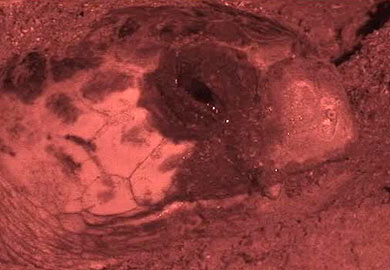DNR News
** Archived Article - please check for current information. **
July 10, 2014
Lights out for loggerheads
The South Carolina Department of Natural Resources asks coastal visitors and residents to keep Lights Out for Loggerheads. Loggerhead sea turtles (Caretta caretta) are present on South Carolina’s barrier islands from May through October. From May through August, loggerheads come ashore to deposit approximately 120 eggs in a nest cavity in the dry sand dune system. Sixty days later, loggerhead hatchlings emerge from the nest at night and head to the ocean. Nests hatch from July through the end of October.
Loggerhead hatchlings are vulnerable to disorientation by artificial lights. When loggerhead hatchlings emerge from the shell, they are attracted to the blue and green wavelengths of celestial light that are naturally reflected off the ocean. They use this natural light to navigate from the nest toward the ocean. “If artificial light on the beach is brighter than the natural ocean horizon, the hatchlings will head toward this artificial source” says Michelle Pate, Sea turtle Coordinator for DNR. Light from streetlights, exterior lights on commercial establishments and beachfront homes can all disorient hatchlings. People on or near the beach carrying flashlights or lanterns and bonfires can also disorient loggerhead hatchlings.
Disorientation of loggerhead sea turtle hatchlings results in increased mortality. Disorientation makes hatchlings more vulnerable to nocturnal predators and desiccation. “While crawling the wrong way on the beach, hatchlings exhaust valuable, limited energy that is needed to swim offshore”, Pate advises. Hatchlings need energy once they reach the ocean to swim to dense floating rafts of seaweed found as far as 60 miles offshore. They use the seaweed as camouflage to protect them from predators. The seaweed is also home to small crustaceans that loggerhead hatchlings eat to replenish their energy.
Loggerheads are listed as threatened under the Endangered Species Act and are protected by federal and state laws. If a sea turtle hatchling is disoriented by artificial light, the maximum federal fine for harming a threatened species is $25,000. County and local lighting ordinances exist to protect sea turtles..
Violating local or county lighting ordinances carry fines up to $500.
As coastal development continues to increase, the number of disorientation events may also rise. If sea turtle friendly light fixtures and bulbs are used, this trend can be reversed. To learn more about available sea turtle friendly products, please visit our “sea turtle and lights” web page..
What You Can Do to Help Sea Turtles in South Carolina
* Obey local and county lighting ordinances.
* Observe from a distance. If you encounter a nesting turtle, do not shine lights on her or take flash
photography. Stay behind the turtle so she cannot see you. Lights and human presence can cause her to
abandon her nest effort.
*Do not touch or prod an animal to move. Stay out of the way as she crawls back to the water.
* Turn off exterior lights visible from the beach, dusk to dawn, from May through October.
* Close blinds and drapes on windows where interior lights can be seen from the beach or ocean.
* No flashlights, fireworks or bonfires on the beach.
* Fill in large holes dug on the beach at the end of the day because adult sea turtles and hatchlings can become
trapped in them.
* Remove beach chairs and other items from the beach and dunes at the end of the day that could obstruct a sea
turtle when nesting or emerging hatchling.
* Adopt-a-Nest
If you encounter sea turtle hatchlings on the beach or an emerging nest:
* Do not approach any sea turtle hatchlings, give them plenty of space.
* Do not carry, guide or help sea turtle hatchlings to the ocean.
* Do not shine any lights on or take flash photography of the hatchlings.
The DNR Marine Turtle Conservation Program is responsible for managing and protecting sea turtles in the state of South Carolina. This program has several all-encompassing components: management, monitoring, research, and education. More specifically, this program implements management techniques to mitigate activities that may impact sea turtles and provides training and support to more than 1,100 volunteers across the coast who protect nests and document sea turtles that wash ashore (strandings). DNR staff members also perform necropsies on fresh dead strandings and respond to live stranded animals in need of care.
To support the SCDNR Marine Turtle Conservation Program:
* Donate (tax deductible) directly to the program. Donations can be sent to SCDNR Sea Turtle Program, PO Box 12559 Charleston, SC 29422-2559
* Purchase an Endangered Species License Plate
* Check-Off for Wildlife when completing your tax returns. Help SCDNR keep wildlife in your life by checking off your contribution to the Endangered Wildlife fund during the tax season.
More News
- S.C. Natural Resources Board meets July 23 in Edisto
- DNR, U.S. Forest Service to provide special youth dove hunt Sept. 6 in Union County
- Coastal Conservation Association helps DNR protect oysters
- Lights out for loggerheads
- New barrier-free fishing pier completed at Lake Edwin Johnson near Spartanburg
- State antler records down slightly this year
- DNR hosts series of family fishing clinics around the state
- Bat disease white-nose syndrome jumps from mountains to Midlands in South Carolina
- Apply online for deer lottery hunts beginning July 1
- Freshwater fishing trends
- Saltwater fishing trends
- S.C. weekly tidetable
- DNR video
- Archived news releases
